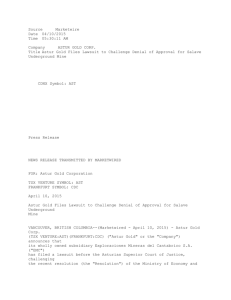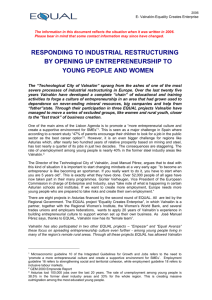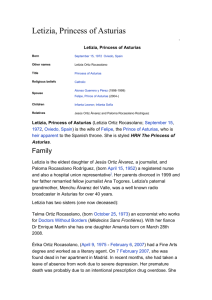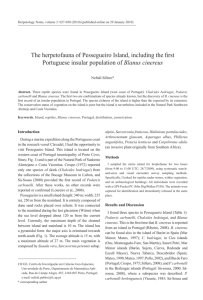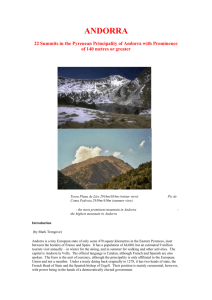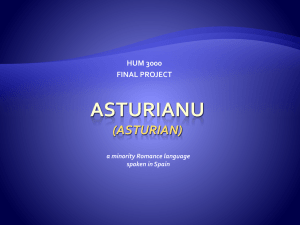the rebirth of the economy asturiana
advertisement
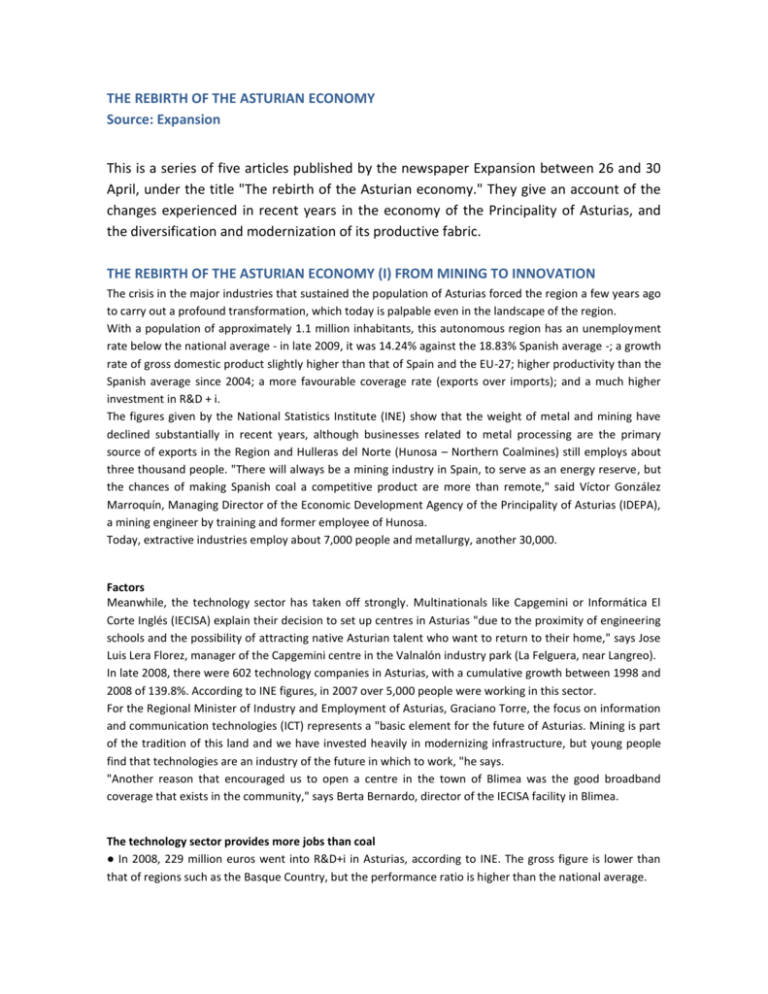
THE REBIRTH OF THE ASTURIAN ECONOMY Source: Expansion This is a series of five articles published by the newspaper Expansion between 26 and 30 April, under the title "The rebirth of the Asturian economy." They give an account of the changes experienced in recent years in the economy of the Principality of Asturias, and the diversification and modernization of its productive fabric. THE REBIRTH OF THE ASTURIAN ECONOMY (I) FROM MINING TO INNOVATION The crisis in the major industries that sustained the population of Asturias forced the region a few years ago to carry out a profound transformation, which today is palpable even in the landscape of the region. With a population of approximately 1.1 million inhabitants, this autonomous region has an unemployment rate below the national average - in late 2009, it was 14.24% against the 18.83% Spanish average -; a growth rate of gross domestic product slightly higher than that of Spain and the EU-27; higher productivity than the Spanish average since 2004; a more favourable coverage rate (exports over imports); and a much higher investment in R&D + i. The figures given by the National Statistics Institute (INE) show that the weight of metal and mining have declined substantially in recent years, although businesses related to metal processing are the primary source of exports in the Region and Hulleras del Norte (Hunosa – Northern Coalmines) still employs about three thousand people. "There will always be a mining industry in Spain, to serve as an energy reserve, but the chances of making Spanish coal a competitive product are more than remote," said Víctor González Marroquín, Managing Director of the Economic Development Agency of the Principality of Asturias (IDEPA), a mining engineer by training and former employee of Hunosa. Today, extractive industries employ about 7,000 people and metallurgy, another 30,000. Factors Meanwhile, the technology sector has taken off strongly. Multinationals like Capgemini or Informática El Corte Inglés (IECISA) explain their decision to set up centres in Asturias "due to the proximity of engineering schools and the possibility of attracting native Asturian talent who want to return to their home," says Jose Luis Lera Florez, manager of the Capgemini centre in the Valnalón industry park (La Felguera, near Langreo). In late 2008, there were 602 technology companies in Asturias, with a cumulative growth between 1998 and 2008 of 139.8%. According to INE figures, in 2007 over 5,000 people were working in this sector. For the Regional Minister of Industry and Employment of Asturias, Graciano Torre, the focus on information and communication technologies (ICT) represents a "basic element for the future of Asturias. Mining is part of the tradition of this land and we have invested heavily in modernizing infrastructure, but young people find that technologies are an industry of the future in which to work, "he says. "Another reason that encouraged us to open a centre in the town of Blimea was the good broadband coverage that exists in the community," says Berta Bernardo, director of the IECISA facility in Blimea. The technology sector provides more jobs than coal ● In 2008, 229 million euros went into R&D+i in Asturias, according to INE. The gross figure is lower than that of regions such as the Basque Country, but the performance ratio is higher than the national average. ● Current Asturian research is very focused on the production of capital goods, healthcare and chemicals. Public subsidies favour collaboration with the University. ● Of the 22,000 miners that worked in Hunosa, just 3,000 remain. Today, Asturias employs more IT people than miners. In support, there are three public venture capital funds. ● Examples of innovative 'start-ups' can already be seen, such as firms that are looking to convert ocean waves into energy or a TV production and 3D animation company in the River Caudal valley. Optical fibre "This is a region with very difficult terrain, which requires us to invest heavily in the deployment of fibre optic networks, which now reach even localities of 500 to 1,000 inhabitants, at 100 megs speed," states Alberto Pérez Cueto , Director General of Modernization of the Government of Asturias. "We are working with carriers on extending Wi-Max connections and, for the most remote areas, on making the satellite link universal, at speeds of 1 or 3.6 megabytes. We hope before the end of the year, that the satellite will reach all the municipalities of Asturias and that it will reach 6 megs," he adds. Improved connections and the arrival of a new industry increase investment in their turn in new innovation projects. In 2008, 229.7 million euros were earmarked for R&D in Asturias. The investment is lower than other regions, but the rate of return is quite high and, moreover, growth is very significant year on year," says Herminio Sastre, Deputy Regional Minister for Science and Innovation in the Principality. The proximity of universities and the cost savings of delocalization attract companies The technology multinationals are imposed between the mines E.A. Asturias The first multinational technology company to install a centre in Asturias was CSC in 1993, whose biggest customer at the time was Dupont. The company currently has a facility in the valley of Tamón and another in Avilés, in an interesting restored old building, a former tannery, in which 38 companies are installed, including the Spanish firm Satec. But this is not the only example. Germany's Software AG has also had a centre in Oviedo since five years ago, and on March 15 opened its new facilities in Avilés. And in the Principality of Asturias Business Park (Pepa), in the same city, work is well advanced on a building that will soon host T-Systems, the information technology (IT) enterprise of Deutsche Telekom. One outstanding feature is that the U.S. Hewlett Packard (HP), a giant that turns over 114,500 million euros per year and employs 321,000 people worldwide, has decided to open a new supercomputing centre on the Mieres campus of the University of Oviedo . The Mieres area was one of those most affected by the mining crisis and more and more projects are being implemented there, many related to information technology, none of which is older than ten years. In the Nalón valley, in the middle of the small town of Blimea, is a development and customer service centre of Informática El Corte Inglés, where the ties worn by employees contrast with the surrounding landscape. Informática El Corte Inglés has other offices for document processing 12 kilometres away, in the Valnalón industrial park (La Felguera). From there, another major multinational for technology services and software deployment, Capgemini provides remote service to its customers throughout Spain. HP to open an advanced technology centre in Mieres this year. From coke chimneys to business parks RECONVERSION / Subsidized land, public support and participation of venture capital have fuelled a new industry near the airport of Asturias. E.A. Avilés In the vicinity of Avilés the old chimneys of the steel industry in Asturias can still be seen. Most are inactive and exist alongside modern industrial parks. This is the case of PEPA (Business Park of Asturias) located near the port of Aviles. There you can find companies that work with metal, like several of the companies of the Daniel Alonso Group; technology companies such as CSC, T-Systems and Software AG, and car dealers. "The design of Pepa was difficult because it had to facilitate access to the port of very large and heavy metal goods, so that trucks would not slow down the rest of the traffic in the area," say sources in the Daniel Alonso Group. To support industrial recovery, the Economic Development Agency of the Principality of Asturias (IDEPAA) has made industrial land available to business at reduced prices. Additionally, the subsidies granted by the Government of the Principality to R&D can reach 40% of the investment. For international promotion of business and innovation and technology centres, non-repayable grants from IDEPAA can reach 50% of the eligible amount. In this context, Daniel Alonso Group, which represents perhaps the most successful case of industrial restructuring in Asturias, has entered fully into research and development of metal equipment for capture of solar, wind and wave energy. Satec In the centre of the town of Avilés, the nearest to the Asturias airport, La Curtidora, the old tannery, has been converted into a business incubator, "the first stop of multinational companies who choose Asturias for relocation, and premises for regional start-ups”, as stated by IDEPA. In this facility are the offices of CSC (this year, all its staff will be concentrated at its new centre in the Pepa) and the Spanish technology consulting firm Satec. The latter came to Asturias three years ago and settled in La Curtidora. Their arrival in the Principality was relatively late, taking into account that the founder and president of the company, Luis Rodríguez Ovejero, is a proud Asturian, from Oviedo. Today, Satec has a hundred or so employees in Avilés, running technology projects for clients in Spain and other European countries. "We have managed to attract very good talented individuals, who find, in the new companies entering Asturias, the opportunity to return to their home," said Manuel Alonso Perez, western area manager of Satec. For start-ups, there are three investment funds in which the Regional Government participates: the Regional Promotion Agency, Sadin, in which Sepi and Hunosa participate, and Sodeco, in which the Principality and Sadin have equal participation. Software AG: five years away from the big city SECOND CENTRE OPENED IN ASTURIAS E.A. Avilés One company that has just arrived in Aviles is the German multinational Software AG. The decision is one more step in the expansion of the technology group in the Principality, since five years ago it opened its first centre in Oviedo. "In Spain we only have offices in Madrid, Barcelona and Asturias," says Carlos Abad, northern area manager of Software AG. "The province gives us two key solutions: the strong support of the public administration, which at one stage met with the company’s international committee to advise on location, and a good supply of qualified professionals due to the presence of computer and engineering studies, and lots of talent with experience willing to return to their home from the big city," says Abad. For this executive, one of the most important business opportunities in the world of enterprise software is related to telemedicine. "The health sector has perhaps the greatest potential for innovation to improve the quality of life," he concludes. Daniel Alonso Group and the advantage of proximity to the port ENGINEERING STEEL STRUCTURES E.A. Avilés It is from the facilities of Grupo Daniel Alonso (GDA), in the Business Park of the Principality of Asturias (Pepa), next to the port of Aviles, that vessels depart to deliver throughout the world industrial parts in excess of 250 tonnes. This holding company, created ten years ago by an Asturian entrepreneur, has used the steel resources of the region, and the proximity of a company like Arcelor-Mittal, to create a giant that includes five companies and that currently bills 450 million euros and employs 2,000 people. Through the Danima company, it sells bodies for commercial vehicles, military logistics and chemical treatment plants, among other products. Tadarsa is specialized in industrial facilities, capital goods (pressure equipment), storage and processing of steel products. Dacero is the line of business responsible for services related to steel, such as sheet metal bending or welding, while IDESA GDA is the name given to a new project to enter the oil markets and large-scale industrial equipment. And finally, Windar is a joint venture created equally by Daniel Alonso Group and Gamesa, producing some of the largest wind towers in the world. Grupo Daniel Alonso manufactures the largest wind towers in the world. Jesus Daniel Salas, director of the centre of CSC in the valley of Tamón. LA CURTIDORA The former tanning factory of Aviles has been renovated and converted into a 'business hotel', a limited company with municipal capital. Currently, 38 start ups and other larger companies such as Computer Sciences Corporation (CSC) and the Spanish Satec have offices and/or industrial units in this building, with more than 5,000 square metres for rent. CSC: the first multinational ICT to reach the Principality Just a few kilometres from Avilés is Tamón Valley. Ten years ago the chemical multinational DuPont arrived here. And together with Dupont, the Computer Sciences Corporation company (CSC), responsible for managing their IT assets, became the first company in its sector to choose the Principality for relocation in 1993. The Dupont and CSC case exemplifies the restructuring of industry in the region. Indeed, in the valley of Tamón the opening is scheduled of a combined cycle plant by the Irish firm Esbi. "At the heart of development, integration and application management and infrastructure in Tamón, we employ 280 people, plus 100 who work in Avilés," says Jesus Daniel Salas, manager of the centre. This year, it is expected that nearly all staff in the region will move to Avilés. THREE FUNDS Asturias participates in three venture capital funds, established as limited liability companies: the Regional Promotion Agency, Sadim (owned by Sepi and Hunosa) and Sodeco (owned by the Principality and Sadim). Outlook no longer so black for youth employment COAL GIVES WAY TO A NEW INDUSTRY Along the rivers Caudal and Nalón several business hubs have been installed in the last decade, with the presence of companies like HP or Rioglass, thus reducing the depopulation in the Asturian mining areas. THE GIFT OF GAUDI This building in Mieres (Asturias) was a gift from the Catalan architect Antonio Gaudí to his friend the second marquis of Comillas in the late nineteenth century. Used as a train station, eight years ago it was renovated by the Rioglass Solar company, which currently has offices there. / Pedro Timon Solinís E.A. Langreo 80% of the population of the autonomous region is concentrated in the metropolitan area of Asturias, which through high-speed roads links the area between the cities Oviedo, Gijón and Aviles. "We wanted to overcome the dispersion of localities and create a concept of metropolis comparable to big cities as regards production levels," said Víctor González Marroquín, managing director of the Economic Development Agency of the Principality of Asturias (IDEPA). The new infrastructures allow the establishment of enterprises in the closest areas: the mining districts, which suffer from strong loss of population, especially of those under 45. Thus, in the Caudal and Nalón river valleys a number of companies have set up that promise a brighter future for Asturian youth. Currently, over 60% of the workforce in mining areas is employed in the service sector, compared with 20% in industry (see chart below). "The whole Caudal basin is designed as one large industrial unit," says González Marroquín. In the Argame business park, one of the closest to Gijon, building work is nearing completion for Gona Principado, a production company founded by Juan Gona, with financial assistance from Sodeco. From here, programmes and drama series will be filmed for the Spanish-speaking world, and 3D animation productions will be made. "We must find new things that employ young people with creative ideas and concerns," said Gona, of Asturian origin. A few kilometres away in the village of Baiña, since 1992, is the company Trituración y maquinaria Auxiliar de Navarra (Triman) (Crushing and Auxiliary Machinery), specializing in the treatment of aggregates and minerals. "This location is ideal for our business, just 15 minutes from Oviedo by road and close to the port of Gijon," says Jesus Muñiz, director of Triman. The improvement of roads has brought the valleys to the main cities of the region Supercomputing Nearby, in Mieres, the U.S. technology giant Hewlett Packard (HP) has opened a supercomputing centre, within the facilities of the University of Oviedo. And the Rioglass group, specializing in the manufacture of special glass, has had for eight years a plant producing 1.3 million mirrors a year for solar thermal power plants. "The oldest companies arrived in river basins a decade ago, attracted by the large tracts of industrial land available and the proximity to major cities in the Principality and its coastal ports,” say Rioglass Solar sources, the renewable energy subsidiary of the group. In the adjoining valley of the river Nalón, companies such as Capgemini, Informática El Corte English and CCS have invaded the towns of La Felguera and Blimea. Capgemini brings a factory with a difference to the Nalón Valley 350 PEOPLE WORKING IN THE LA FELGUERA 'SOFTWARE FACTORY' E.A. Langreo "Many people in La Felguera still ask us what we manufacture. In the Nalón mining district, wealth is still measured by the size of things manufactured," jokes Jose Luis Lera Florez, manager of the centre that Capgemini has operated in the Valnalón industrial park (La Felguera, close to Langreo), since 2005. "It's not easy to explain what a software factory is," he says. The French company Capgemini is credited with creating the first software factories (common nowadays among companies in this sector), devoted to the development of IT solutions. Later, technological service centres are responsible for implementing complex IT tools and adapting them to customer needs. A few metres away, Informática El Corte English has another facility. "Asturias was the first centre we opened, after Madrid and Barcelona, as part of a corporate relocation strategy. Staff turnover before the opening of facilities outside the major cities was very high, between 25% and 30%. Today, it is hardly significant," says Lera Florez. 350 of the 5,000 employees of Capgemini in Spain work In the La Felguera centre. "We deal mainly with the maintenance and remote development of applications, and also do some business process outsourcing," he says. The software factory of La Felguera also acts as a centre of excellence for all of Europe. 'Cloud' Last year, Capgemini took a step forward in the field of cloud solutions, which already represents 60% of the Asturian core business. "We want to add value and expertise to the integration of web tools", sums up this Spanish executive. The group last year bolstered its web area, which already accounts for 60% of the centre’s activity The facility acts as a centre of excellence for its customers across Europe Informática El Corte English is the tie to its centre of Blimea THIS WAS THEIR FIRST 'OUTSOURCING' INSTALLATION IN SPAIN E.A. Langreo In the small town of Blimea near Langreo, there is a building that stands out from the rest. Next to the municipal bowling alley and a small church stands a modern building on what was once the village school. Here work 112 employees of Informática El Corte Inglés (IECISA), the group’s company specializing in computer services for businesses. "The Blimea centre was the first to open after Madrid and Barcelona, in 2007. We chose this location because they had a good fibre optic network," said Berta Bernardo, manager of the centre. "The Principality offered us this facility and, as it was bigger than we intended at first, we set up more business areas here," says Bernardo. From Blimea, they deal with everything from customer service to software development. Most employees are young people under thirty, all sharing a trait that makes them easy to distinguish among other citizens of Blimea: formal dress, preferably with a tie. "For them, we are a good opportunity to work close to home, in a company that offers professional development," says Bernardo. Just ten minutes away, IECISA has another facility in the Valnalón industrial estate (La Felguera), which carries out document processing tasks and where another twenty people work. "Our machines are capable of scanning 40,000 documents per day," says Bernardo. IECISA facility in the old school of Blimea (Asturias). A 'Silicon Valley' on the Gijón campus TECHNOLOGY PARK / The Asturian city has plans for the environment of the Universidad Laboral to be an area of collaboration between training, businesses, foundations and institutions. Team projects achieve higher public subsidies. E.A. Gijón Gradually, the commitment of the Asturias region to innovation and development is becoming more palpable. "The number of technology companies has greatly increased, perhaps not with intensive investment and capital, but they are central to the creation of skilled jobs," said Graciano Torre, Regional Minister of Industry and Employment of Asturias. To encourage the development and competitiveness of technological SMEs Gijon has seen the creation, next to the Universidad Laboral, of a science and technology park that brings together companies in the ICT sector, a number of start-ups in the field of biotechnology, and offices of public bodies dedicated to the economic promotion of the region, such as the Economic Development Agency of the Principality of Asturias (IDEPA) and the CTIC Foundation. The latter, in turn, is home to the international Internet standards body W3C. This complex, known as the mile of knowledge, acts as an Asturian Silicon Valley, where the university, companies and institutions collaborate and work together to obtain public subsidies for R&D. At present, these can reach 40% of the investment. "Grants and subsidies provided by the Government of Asturias follow very similar criteria to the Framework Programme of the European Union," says Herminio Sastre, Deputy Regional Minister for Science and Innovation in the Principality. "In this sense it is more viable for a project involving a group of companies of various sizes, along with a university or public institution, to receive financial aid," he adds. But what kinds of projects are more likely to receive public funding? “Investment in biomedical research, technological renovation and development of communication systems are some of the strategic lines for the next year in the healthcare field. Projects are also under way related to the adoption of capital goods for other uses, mainly environmental," says Sastre. Next to the Universidad Laboral of Gijón, a technology park has been built, which also has room for public institutions. / Pedro Timon Solinís Within the mile of knowledge, an ICT cluster has formed, consisting of sixty companies that generate over 2,000 direct jobs and move more than 200 million euros annual turnover. NeoMetrics One of the firms participating in the ICT cluster is Neo Metrics, a consultancy specializing in analytical intelligence that has earned the respect of the market after winning awards such as the KDD Cup in San Francisco (the most important global competition reserved for companies and institutions specialized in database analysis), in 2007, or that of the National Association of European Business and Innovation Centres (Ances), a year later. NeoMetrics comprises more than one hundred workers between their delegations in Madrid, Barcelona, Gijón and its two offices in Los Angeles. "Our goal is to help organizations to maximize the value of information and make more accurate strategic decisions through the application of advanced quantitative models," says Jose Luis Flores, founder and CEO of the firm. NeoMetrics markets systems for 70% of Spanish banks and about half of national operators. It is also betting heavily on the online sector, by providing a tool capable of determining in real time the prices of advertising space on the Internet. Another use of such analytical tools is recommendation based on user preferences, as do sites such as, for example, YouTube or Amazon. Idesa Another company that has offices in the science and technology park of the Universidad Laboral is Idesa, an engineering company specialized in manufacturing and assembly in the capital goods sector. In the Park in Gijón, IDESA has a technical and marketing support centre under the name Idesa Technical Consortia. The company also plans to start construction this year of a research centre in this location, which will be aimed at renewable energies, notably wind and wave energy. The new building represents an investment of 36 million euros over the next four years, with support from the regional government that may reach 50% of this amount. It is not the first time that the executive branch of the Principality has signed partnerships to promote R&D+i with other major companies in the region. Previously, this was done with ArcelorMittal, ThyssenKrupp Elevator, Duro Felguera, HC Energy, Temper, Feve, CAF. Currently, IDESA exports over 90% of its production and bills around 63 million euros per year. The Ctic foundation houses the offices of the W3C web standards body in Spain The Thyssenkrupp prototype laboratory has real-size models of products. Thyssenkrupp For its part, ThyssenKrupp is one of the big multinationals established in Asturias. The group has for years had a facility in the town of Mieres, in the Caudal district, which develops passenger walkways for access to the A380 superplanes. The company chose for its offices in Gijón the Universidad Laboral itself in a space left free next to the drama school. Just behind the Laboral building, the firm has a large hall serving as a prototype laboratory. Here escalators and aircraft walkways are tested, actual size, prior to marketing. In total, Thyssenkrupp employs 900 people in Asturias, "and generates a turnover of 130 million euros a year," says Javier Sesma, business development manager for the company. A few examples ● The Ctic foundation is a driving force behind the development of open technologies. ● NeoMetrics was founded in Madrid in 2003 and recently opened new offices in Gijón. ● Ides already has a facility in the technology park of the Laboral and plans to build another for 2012. ● ThyssenKrupp employs 900 people in Asturias. Temper gets ready for the coming electric car boom NEW USES FOR ELECTRICAL BOXES / The group, which started out as a family business, has committed its Crady company to the development of electric car charging points. It expects to sell 500 units in Spain by 2012. In the picture, one of the Temper-designed charging points for electric cars. / Grupo Temper Foreign markets ● Temper Group exemplifies the international vision of more and more firms in Asturias, with subsidiaries in Portugal, Mexico, Poland and China and distributors on five continents. ● The Daniel Alonso Group of Avilés sells heavy metal products to Mexico, Africa, Eastern Europe and Asia. ● At the Universidad Laboral of Gijon, Thyssenkrupp has an international centre for R&D. It also manufactures walkways and escalators for the worldwide market in the region. ● From the Caudal valley, Triman exports to Eastern Europe, North Africa, Latin America, Japan and France, among other destinations. ● Rioglass Solar produces 1.3 million solar thermal mirrors per year, equivalent to 3.5 million square metres in the town of Mieres. E.A. Gijón Temper Group was founded three decades ago by the father of the current general manager, Adriano Monés Bayo. At present, it consists of fourteen companies linked to the world of energy and, for this year, expects to reach a turnover of about 100 million euros. The group has maintained its headquarters in Asturias, which was not incompatible with an international vision starting from its roots. It has subsidiaries in Portugal, Mexico, China and Poland, and distributes products throughout the rest of Europe, America, Africa and Oceania. "In the world, but also in Spain, we have competitors with higher levels of production and, therefore, greater economies of scale. In this context, we need to compete through innovation," says Monés Bayo. In 2007, "with the looming crisis in the power sector, we decided to enter other markets, such as clean energy, and created a blog for communication with customers, based on which we started to consider our chances in the electric car market," he recalls. Thus, in the company's 7,000 square metre Crady factory in Gijón, a series of electrical boxes were designed, for urban and indoor use, for recharging the batteries for the next generation of cars. "It's a wager on the future. First, because it is unclear when the industry will really take off, and second, because there will be different plans in each autonomous region, and even more, in each country,” acknowledges this Spanish executive. Also, "there are strong pressures to delay the adoption of these new vehicles by the oil companies, for obvious reasons," says José María García Riera, marketing manager for the group. Meanwhile, "some building companies see in the electric car a good business opportunity during the building crisis," he added, referring to the role of ACS in the adaptation of the Movele plan for the Community of Madrid. Prospects This "commitment to the future" already appears to be seeing the light at the end of the tunnel. "In Asturias, a replica of the Movele plan has been designed by the Regional Ministry of Industry and the Principality will subsidize up to 50% of our investment, which we expect to be 10 million euros between 2008 and 2012," says Garcia Riera. "If things go well, we expect to sell 500 units in Madrid, Barcelona and Seville, which will serve about 2,000 vehicles for 2012," he says. The challenge is not unreasonable, bearing in mind that the Movele plan's target is to market 2000 electric cars by the end of this year. "The battery accounts for 70% of the cost of an electric car. Therefore, it is very important to have safe recharging points, which will prevent short circuits and power surges, and will allow users to control consumption," states Garcia Riera. "We are being very active in promoting our recharging point models, and are confident that when this market explodes, people will remember us, that we are a company specialized in high security electrical boxes," he concludes. "We are working with the next generation of Internet" THE W3C AGENCY HAS ONE OF ITS OFFICES IN CTIC, WHERE STANDARDS FOR THE NETWORK FUTURE ARE DEVISED E.A. Gijón The CTIC Foundation is a neutral non-profit body committed to regional development, created by the Government of the Principality of Asturias and a number of technology companies in the sector of information and communication technologies (ICT). But their offices, in the technology park next to the former Universidad Laboral of Gijon, are home to another powerful initiative: the Spanish headquarters of W3C, the international body that defines Internet standards. In this space, day after day, eleven researchers are designing the network of the future. "For us, it's a great advantage to be working with W3C, because we can operate in what will be the next generation technologies," says Pablo Priesca, general manager of the CTIC Foundation. This Asturian body has a threefold activity. The Technology area seeks, with the always-present inspiration of W3C, to create systems that will allow standardization, accessibility and mobility of information, especially regarding eadministration. According to Priesca, Spain is heading towards the unification of standards in eadministration. "This is a process that is starting now and that has to do with cost savings. The path is irreversible," he says. Pablo Priesca, managing director of the Ctic Foundation. / Pedro Timon Solinís "One day, the government will make public data available to all " W3C is leading an international project involving 36 countries, pressing for all public data to be available on the Web, in open formats and reusable by third parties. "The technique for databases to be interoperable with each other is already developed, but has not yet reached the market. The furthest it has come has been to implement systems that link the information but do not make it reusable, as in the U.S.," says Priesca. "One day not too far off, some search engines will link public and private data - not web-pages - to provide the most accurate and complete information possible," he adds. This is what is known as the semantic web. For this expert in information technology, the reason for the current delay has to do with "the fear of violating the privacy of individuals. Security can be controlled. There is no point in forever restricting access to better information on police, courts and people in general,” maintains Priesca. Other activities Ctic’s Information Society area implements its progress among the public, businesses and institutions. It also carries out cooperation projects in developing countries such as Mali, Angola, Peru, Bolivia, El Salvador and Honduras, for computer education and reducing the digital divide.
